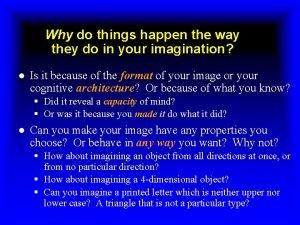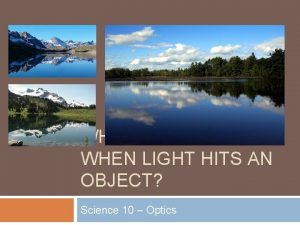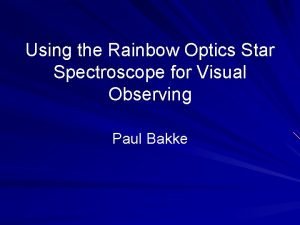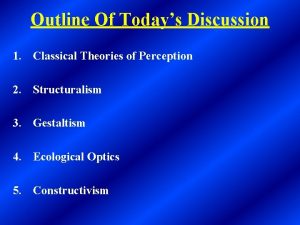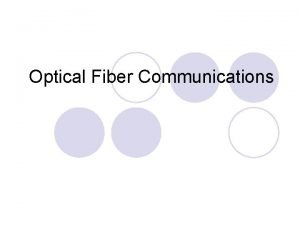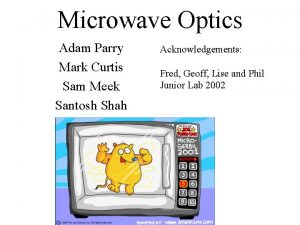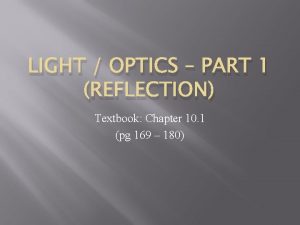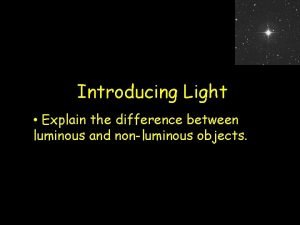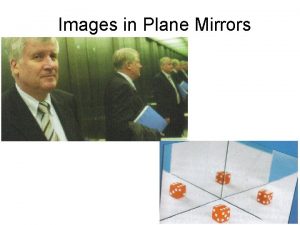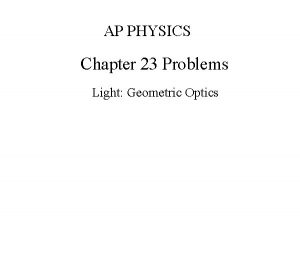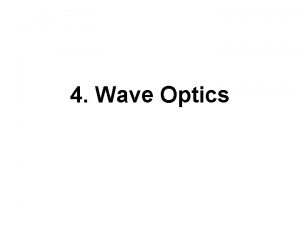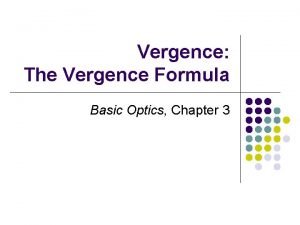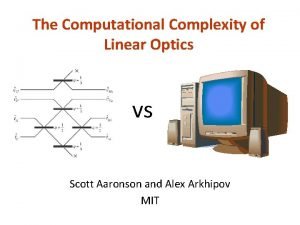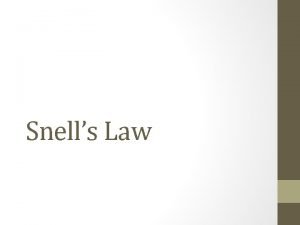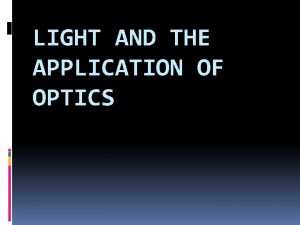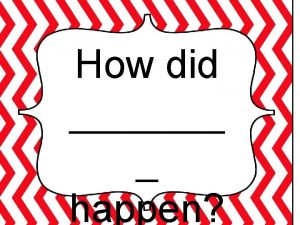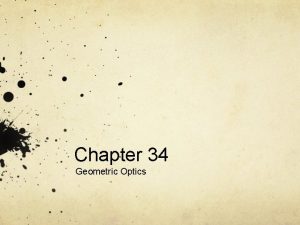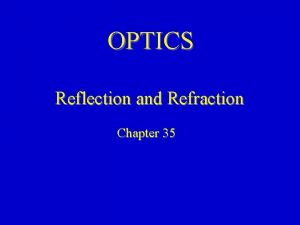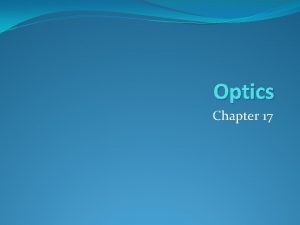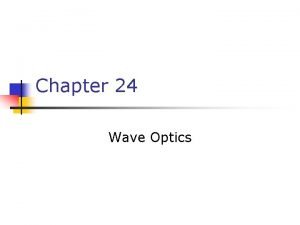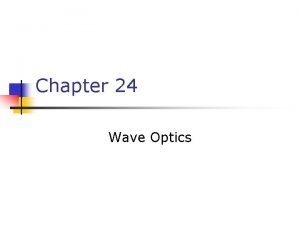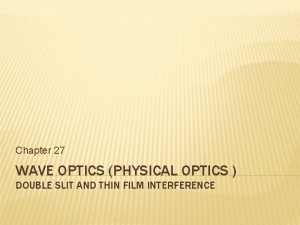Chapter 19 OPTICS What five things can happen





































- Slides: 37

Chapter 19 OPTICS

What five things can happen to light that strikes a new medium? 1. 2. 3. 4. 5. Reflected Absorbed Refracted Polarized Scattered Which of the following makes an underwater object appear closer and larger than it really is? c. Refraction a. Reflection b. Absorption c. Refraction d. Transmission

Ray Diagram – a model or a drawing that shows how light rays change direction when they strike mirrors and pass through lenses.

Law of Reflection – States that the angle of reflection is equal to the angle of incident. Angle of incident – The angle the incident ray makes with a line drawn perpendicular to the surface of the mirror. Angle of reflection – The angle the reflected ray makes with the perpendicular line.

When behind an 18 -wheeler, if you can’t see the truck driver’s mirrors, then they can’t see you. GET BACK! The law of reflection may get you killed! Light travels from you to the mirror to the driver’s eyes, and from the driver’s eyes to the mirror and to you.

A plane mirror – A mirror with a flat surface. It always produces a virtual image. Virtual image – a copy of an object formed at the location from which the light rays appear to come. The light rays appear to come from behind the mirror but they do not. The girl sees a virtual image of herself in the plane mirror. Virtual images such as this cannot be projected onto a screen. Notice how the girl’s right hand appears to be her left in the virtual image. This is a right-left reversal.


Concave and Convex Mirrors Concave Mirror - When the inside surface of a curved mirror is the reflecting surface. Focal Point – The point at which the light rays meet. Real Image – A copy of an object formed at the point where light rays actually meet. Unlike a virtual image, a real image can be viewed on a surface such as a screen. Concave mirrors can form either real or virtual images.

When parallel incoming rays strike a concave mirror, they are reflected through the focal point. Concave mirrors form real images when the reflected light rays converge. Concave mirrors form virtual images when the reflected rays appear to come from a point behind the mirror.

Concave mirrors are often used in automobile headlights and flashlights to direct the illumination from a single bulb into a beam.

Convex Mirror – When the outside surface of a curved mirror is the reflecting surface. Convex mirrors always cause the light rays to spread out and can only form virtual images. When parallel incoming rays strike a convex mirror, they are reflected away from one another. Concave mirrors always form virtual images that are upright and smaller than the object.

Because of their reduced image size, convex mirrors on automobiles warn that, “Objects are closer than they appear. ”

Concave and Convex Lenses Lens – An object made of transparent material that has one of two curved surfaces that can refract light. The curvature and thickness of a lens affect the way it refracts light.

Concave lens is curved inward at the center and is thickest at the outside edges. Concave lenses always cause light rays to spread out and can only form virtual images. They are often used in viewfinders of cameras. The small virtual image you see through the viewfinder is similar to what the photo will look like. They are also used in conjunction with mirrors in telescopes.

When parallel incoming rays strike a concave lens, they are refracted away from one another. As the light rays diverge after passing through the concave lens, they form a virtual image of the object.

Convex lens is curved outward at the center and is thinnest at the outer edges. As rays pass through the lens, each one is refracted and they emerge at different angles. Convex lenses cause incoming parallel rays to come together or converge. The converging rays meet at a single point called the focal point on the side of the lens opposite to the object. Convex lenses form either real or virtual images. They are used in slide projectors, movie projectors, cameras, and lighthouses. You don’t see an upside down image in a movie theatre because the film is actually placed upside down in the projector.

When parallel incoming rays strike a convex lens, they are refracted toward each other and pass through the focal point. When an object is located beyond the focal point of a convex lens, a real image is formed. A magnified, virtual image is formed when the object is located between the focal point and the lens.

Index of Refraction of Light In a vacuum, light travels at a speed of 3. 00 X 108 m/s. Once light passes from a vacuum into any other medium, it slows down. The speed of light in the new medium depends on the material of the new medium. For example, the speed of light in water is 2. 25 X 108 m/s. When light enters a new medium at an angle, the change in speed causes the light to bend, or refract. The index of refraction for a material is the ration of the speed of light in a vacuum to the speed of the light in the material. Luster is the measure of the amount of light that strikes a gemstone’s surface and is reflected.

Properties of Natural and Synthetic Gemstones Gem Index of Refraction Luster Diamond 2. 42 17. 2% Moissanite 2. 65 20. 4% Ruby 1. 77 7. 4% Sapphire 1. 77 7. 44% Emerald 1. 58 4. 8%

Gem Diamond Moissanite Ruby Sapphire Emerald Index of Refraction Luster 2. 42 2. 65 1. 77 1. 58 17. 2% 20. 4% 7. 4% 4. 8% The speed of light through an unknown gemstone is 1. 69 X 108 m/s. Identify the gemstone. Index of refraction = 3. 00 X 108 m/s (3. 00 X 108 m/s) / (1. 69 X 108 m/s) = 1. 77 Could be either a ruby or a sapphire If a light ray strikes each gem at an angle, in which gem would the light ray bend the most? Moissanite because it has the greatest index of refraction.

Total Internal Reflection Critical Angle – The angle of incidence that produces an angle of refraction of 90 degrees. Total Internal Reflection – The complete reflection of a light ray back into its original medium. Materials that have small critical angles are likely to cause most of the light entering them to be totally internally reflected. Fiber optic strands make use of this and are capable of transmitting data in the form of light pulses over large distances with little loss in signal strength. It also makes the speed faster than conventional methods such as copper cable.

When a ray hits the glass-air boundary at an angle less than the critical angle, it is partly refracted and partly reflected. At the critical angle, the angle of refraction is 90 degrees. When the critical angle is exceeded, all of the light is reflected. Total internal reflection occurs.

Cameras – An optical instrument that records an image of an object. Light rays enter a camera through an opening, are focused by the opening or lens, and form an image that is recorded on film or by a sensor onto flash or other media. The word “camera” is Latin for “room. ” Early cameras were the size of an entire room and were known as “camera obscura” or dark room. One of the earliest uses of a camera is credited to Leonardo de Vinci.

The eye and vision You will be responsible for knowing the parts of the eye. Page 589.

Cornea – The transparent outer coating of the eye. The cornea’s curved surface helps to focus light entering the eye. Pupil – The opening that allows light to enter the eye. This is the part of your eye that looks black. Iris – The colored part of the eye that contracts and expands to control the amount of light that enters the eye. Lens – This is a convex lens that is sealed in a capsule containing a clear fluid. The lens focuses the light onto the light sensor cells at the back of the eye. Muscles change the shape of the lens allowing you to focus on distant or near objects. If you read for a long time, your eyes become tired due to the muscles being contracted for a long period of time. The best way to relax your eyes is to look at objects that are far away.

Retina – The inner surface of the eye where the focused, refracted light is collected. Its surface is covered by light sensitive nerve endings called rods and cones. These convert the light into electrical signals that are sent to the brain through the optic nerve. Blind spot – The area of the retina where the nerve endings come together to form the optic nerve. This spot contains no rods or cones and cannot sense light. Low-intensity light is sensed by rods. The brain uses signals from rods to distinguish among white, black, and different shades of gray. Cones are sensitive to color, but are less sensitive than rods so they need more light than rods in order to function. This explains why you can’t distinguish colors in low light situations. There are three different types of cones and each is only able to distinguish a single color – red, green, or blue.

Vision Problems People who are colorblind have missing or defective cones for one or more of the three kinds of cones. Nearsightedness – A condition in which the rays focus before they reach the retina. This occurs in ¼ people. Causes distant objects to seem blurred. Caused by either the cornea is too curved or the eyeball is too long.


Farsightedness – a condition that causes nearby objects to appear blurry. Common causes are either a cornea that is not curved enough or an eyeball that is too short. Either case, the rays of light focus too far from the lens and behind the retina.


Astigmatism – A condition in which objects at any distance appear blurry because the cornea or les is misshapen. This irregularity prevents light from properly focusing on the retina. The result is that the lens has two different focal points, causing distortion or blurring of the image. Specialized eyeglass lens shapes are used to correct this.

Optical Instruments Telescope – an instrument that uses lenses or mirrors to collect and focus light from distant objects. There are two main types of telescopes: Reflecting Telescope – uses mirrors and convex lenses to collect and focus light. Light from a distant object strikes a large concave mirror and is brought to a focus. The focused light is reflected by an angled mirror and forms a real image. The convex lens of the eyepiece then enlarges the image.

Refracting Telescope – uses convex lenses to collect and focus light. Light from a distant object enters the telescope by passing through a convex lens called the objective lens. The convex lens forms a real image at its focal point inside the telescope. A convex lens in the eyepiece then magnifies this real image. As you look through the eyepiece, you see an enlarged, upside down, virtual image of the real object.

The reflecting telescope uses a large concave mirror to focus light rays The refracting telescope uses a series of lenses to focus light from distant objects.

This is a single lens reflex camera (slr). The mirror reflects the image through the viewfinder so the photographer can bring it into focus. When the shutter button is pushed, the mirror flips up allowing the focused light rays to pass straight through the lens system onto the film.

Microscopes – an optical instrument that uses lenses to provide enlarged images of very small, near objects. The compound microscope uses two convex lenses to magnify small objects. To view an object, place it on a glass slide. Then place the slide on the stage above the light source. Light from below pass through the object and then pass through a convex lens called the objective. The lens produces an enlarged upside – down real image. This image then becomes the object for the second convex lens called the ocular which enlarges the image. When you look through it, you see a virtual image of the object.

Assessment page 595 and Test Prep Page 597 TEST…… Next chapter will be chapter 18
 The order in which things happen
The order in which things happen Difference between ray optics and wave optics
Difference between ray optics and wave optics Venn diagram of geometric optics and physical optics
Venn diagram of geometric optics and physical optics Why things happen the way they do
Why things happen the way they do Through you i can do anything i can do all things
Through you i can do anything i can do all things What happens when light hits an object you can see
What happens when light hits an object you can see Can the dust bowl happen again
Can the dust bowl happen again These beauteous forms
These beauteous forms One in five challenge
One in five challenge 5 elements and 5 senses
5 elements and 5 senses Macbeth seyton i am sick at heart
Macbeth seyton i am sick at heart Five kingdoms science
Five kingdoms science Foundations u.com
Foundations u.com Neil postman five things
Neil postman five things Five kingdoms of living things
Five kingdoms of living things 5 themes of geography notes
5 themes of geography notes Is protoctista autotrophic or heterotrophic
Is protoctista autotrophic or heterotrophic Difference between living and non living organisms
Difference between living and non living organisms 7 life proceses
7 life proceses Rainbow optics star spectroscope
Rainbow optics star spectroscope Gestaltism
Gestaltism Turba optics
Turba optics Optical power loss
Optical power loss Adam ekt eva
Adam ekt eva Bill nye reflection and refraction
Bill nye reflection and refraction Grade 10 optics
Grade 10 optics Physics 241 purdue
Physics 241 purdue Luminous source
Luminous source Ambulance in plane mirror
Ambulance in plane mirror Hotwire salisbury nc
Hotwire salisbury nc Http //www.phys.hawaii.edu/ teb/optics/java/slitdiffr/
Http //www.phys.hawaii.edu/ teb/optics/java/slitdiffr/ Optics topics
Optics topics With the rule astigmatism
With the rule astigmatism Geometric optics problems
Geometric optics problems Fourier optics
Fourier optics Vergence formula
Vergence formula The computational complexity of linear optics
The computational complexity of linear optics What is the snell's law
What is the snell's law



